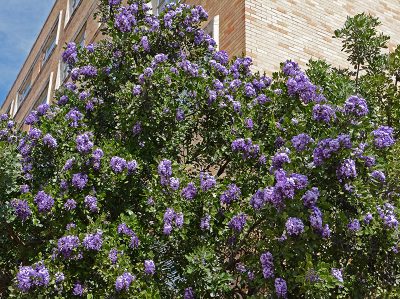Mountain Laurel
Sophora secundiflora

This native shrub/small tree is an evergreen that is extremely drought tough. Even in years of extreme drought, they survive when other natives have died. It is a slow grower, but well worth the wait. It’s an excellent screening or accent tree.
Height at maturity: 10-20 feet tall; 8 to 12 feet wide
Light: full sun is best but can take part shade.
Soil: Adapts to most soil types but wants good drainage. Do not over water once it is established. It has a very long tap root, which makes it drought-tough (but also harder to move!).
Flowers: Large scented flowers in early spring that attract all kinds of beneficial insects. Many people describe the fragrance as grape Kool-Aid!
Why not bloom: Maturity is one reason. The other: pruning off flower spikes, which form very quickly in spring, just after this year’s flowers. These knobby growths may look odd, but they represent next year’s flowers. Mountain laurels should only be pruned at trunk branches to shape (if necessary).
Also, Texas mountain laurel can be attacked by the Genista caterpillar. In one day, they can defoliate a tree, so be sure to apply Bacillus thuringiensis (Bt) at the first outbreak. Most likely, you will only have to spray once, but in intense invasions, you may not need to reapply. This foliar application will disrupt the caterpillars’ digestive system and they will stop feeding and die in a few days.
Deer resistance: Yes.
Seeds: The seeds are poisonous if swallowed, but not dangerous otherwise. Once fully mature, the seed pods turn dark brown or gray, and the seeds inside are dark red. The seeds have a very heavy seed coat, making them hard to germinate. But if you wish to try, it’s best to harvest the seed pods before they are fully developed and plant the seeds before they have turned red.
categories:
